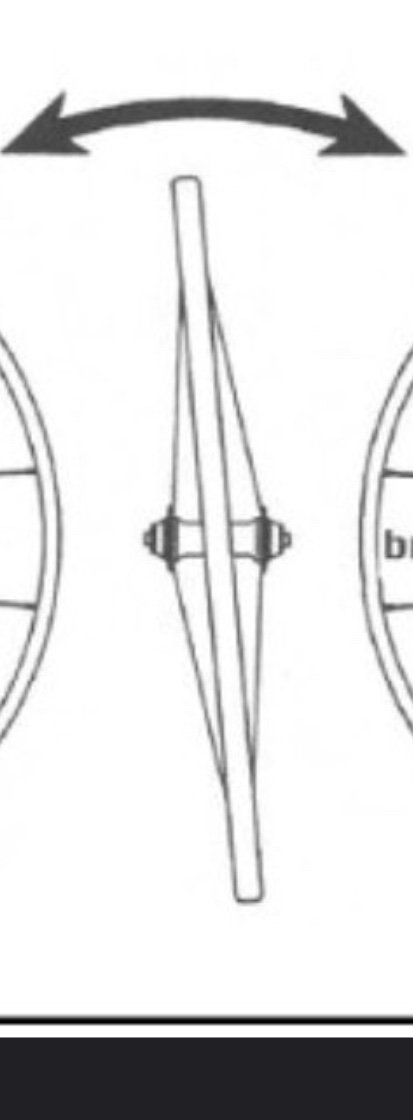I just got done with you on that brake heat debate and am not really interested in debating you on yet one more of your physics misconceptions.
What’s the fun in that?
Yes, you can dissect the force into the horizontal and vertical component forces, that's how a free body diagram works, but that doesn't mean the horizontal force exists on its own. The vertical component is there too. The summed force vector is in the plane of the bicycle wheel.
I never said the horizontal force exists on its own. But the horizontal force exist and it does have an effect on the forces on the wheel. The bicycle wheel is a tensioned structure which behaves differently from a rigid structure. The rim is detensioned (slightly) directly above the contact patch. The rim deflects upward when the wheel is vertical and it deflects out of plane when angled. Although exaggerated, this illustration shows what happens to the rim when cornering. The spokes on the outside of the curve are going to undergo a decrease in tension while the spokes on the inside of the curve are going to undergo an increase in tension. Because the structure isn’t solid, the rim can float on the spokes and will bend
more in response to side loads in a corner than rigid wheel would.

That said, the balance between the tension on the spokes on each side of the wheel keeps the wheel from collapsing. It doesn’t mean that the rim won’t bend upward but only that the whole structure doesn’t collapse.
This is part of the fundamental balancing mechanic of bicycles. You are always leaning the bike to the exact degree such that the force is straight down from the perspective of the bike. That's how the bicycle stays upright. The bicycle is a bizarre device that has no left-right support. You must always keep the force completely straight downward via manual corrections, or you will topple over left or right. This applies to both straight riding and corner riding. You must always keep that force straight down in order to remain in balance. There is never any lateral force as long as you are riding the bicycle properly. If you ever find yourself experiencing a lateral force, it means you've f'ed up your steering and you are now currently in the process of falling over.
That’s not how that works. In a corner your center of gravity is not “straight down” nor is it aligned with the ground. Your CG can be quite a bit to one side of being aligned with the bike and can be way off to one side. The limiting factor is that sideways force and the friction of the tires.
If you wish to experiment: go to your rim brake bike. Release the cable tension on the brake arms. Grab your rim next to where the brake pads are and wiggle it side to side. Notice how you can move the rim side to side about 5mm with very little hand force.
5mm of side to side play? Say what? Only if your spoke tension is barely enough to have engaged the spokes in the rim. 5mm of play would be a lot for a wheel in the initial stages of building.
This is because bicycle wheels are not very stiff laterally.
I don’t disagree that they aren’t as stiff laterally as they are horizontally but that was sort of my point. Bike wheels are stiff enough laterally that they won’t go out of true simply because you hit a bump or because you drop the bike on the ground. Trap the wheel in something and the wheel is going to bend like an untensioned spoke but for “just riding along” you aren’t likely to make the wheel go out of true because of a crash. If you notice that the wheel is out of true after 150 km of riding after a crash, I would attribute the lack of trueness to be due to some other event.
Now set your brakes back into place. How much gap do you keep between the pad and the rim? I build my own wheels and like to keep my brake levers responsive, so I set my pads only 1.5mm from the rim. You might have a bit more. If there was any lateral force on the rims during turns, they'd be rubbing the brake pads in every corner. I don't know about you but my pads do not rub when I turn corners.
No, the rim would not bend at the brakes (unless the wheel is severely under tensioned). The angle of the bend in the illustration above is not the only thing that is exaggerated. The force on the rim is going to be at the contact patch and only that part of the rim is going to deflect away from being perpendicular with the hub. Since the rim isn’t very rigid, the spokes on the upper part of the wheel are going to keep the rim perpendicular with the hub. The actual picture of the wheel will be more like a hockey stick than what is depicted in the illustration.
Again, this is all predicated on a wheel under proper tension.